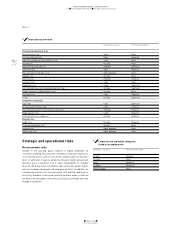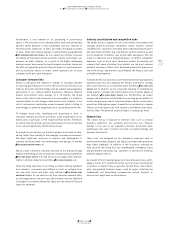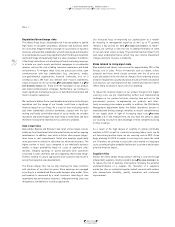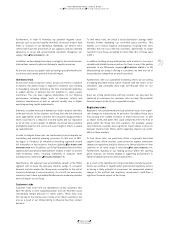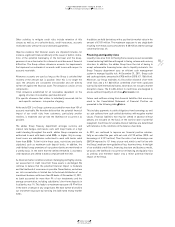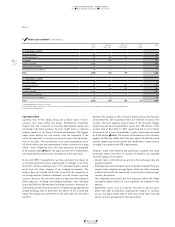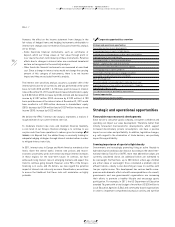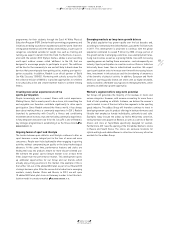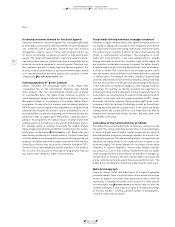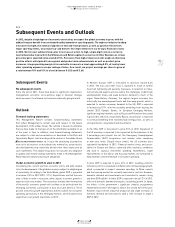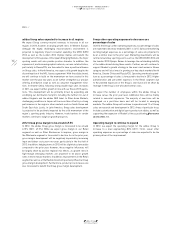Reebok 2011 Annual Report Download - page 162
Download and view the complete annual report
Please find page 162 of the 2011 Reebok annual report below. You can navigate through the pages in the report by either clicking on the pages listed below, or by using the keyword search tool below to find specific information within the annual report.
adidas Group
2011 Annual Report
GROUP MANAGEMENT REPORT – FINANCIAL REVIEW
158
2011
03.4 Risk and Opportunity Report Financial risks Strategic and operational opportunities
03.4
However, the effect on the income statement from changes in the
fair values of hedged items and hedging instruments attributable to
interest rate changes was not material. Exclusions from this analysis
are as follows:
− Some fixed-rate financial instruments, such as certificates of
deposit, which our Group values at “fair value through profit or
loss” due to the short-term maturity of these instruments. Potential
effects due to changes in interest rates are considered immaterial
and are not recognised in the sensitivity analysis.
− Other fixed-rate financial instruments are measured at amortised
cost. Since a change in interest rates would not change the carrying
amount of this category of instruments, there is no net income
impact and they are excluded from this analysis.
The interest rate sensitivity analysis assumes a parallel shift of the
interest yield curve for all currencies and was performed on the same
basis for both 2010 and 2011. A 100 basis point increase in interest
rates at December 31, 2011 would have increased shareholders’ equity
by € 0.00 million (2010: increase by € 0.04 million) and decreased net
income by € 0.07 million (2010: decrease by € 0.22 million). A 100
basis point decrease of the interest rates at December 31, 2011 would
have resulted in a € 0.00 million decrease in shareholders’ equity
(2010: decrease by € 0.04 million) and a € 0.07 million increase in net
income (2010: increase by € 0.22 million).
We believe the IFRS 7 interest rate analysis represents a realistic if
rough estimate of our current interest rate risk.
To moderate interest rate risks and maintain financial flexibility,
a core tenet of our Group’s financial strategy is to continue to use
surplus cash flow from operations to reduce gross borrowings
SEE
TREASURY, P. 129
. Beyond that, the adidas Group is constantly looking for
adequate hedging strategies through interest rate derivatives in order
to mitigate interest rate risks.
In 2011, interest rates in Europe and North America remained at low
levels. Given the central banks’ interest rate policies and macro-
economic uncertainty, we do not foresee any major interest increases
in these regions for the near-term future. In contrast, we have
witnessed rising interest rates in emerging markets and expect this
trend to continue going forward. However, since 90% of the Group’s
financing is in euros and US dollars, we now regard the potential
impact of interest rate risks only as minor. Nevertheless, we continue
to assess the likelihood that these risks will materialise as highly
probable.
Strategic and operational opportunities
Favourable macroeconomic developments
Since we are a consumer goods company, consumer confidence and
spending can impact our sales development. Therefore, better than
initially forecasted macroeconomic developments, which support
increased discretionary private consumption, can have a positive
impact on our sales and profitability. In addition, legislative changes,
e.g. with regard to the elimination of trade barriers, can positively
impact Group profitability.
Growing importance of sports to fight obesity
Governments are increasingly promoting living an active lifestyle to
fight obesity and cardiovascular disease. According to the latest Inter-
national Obesity Task Force (IOTF), more than 600 million adults are
currently considered obese. An additional billion are estimated to
be overweight. Furthermore, up to 200 million school-age children
are either obese or overweight. Once considered a problem only in
affluent nations, obesity is also becoming an issue in countries with
low per capita income. This development has serious health conse-
quences and a dramatic effect on health care expenditures. As a result,
governments and non-governmental organisations are increasing
their efforts to promote a healthy lifestyle and encourage sports
participation. For example, in 2011, the US Department of Education
awarded 76 grants with a total budget of more than US $ 35 million to
Local Education Agencies (LEAs) and community-based organisations
in order to implement comprehensive physical activity and nutrition
07 Corporate opportunities overview
Strategic and operational opportunities
Favourable macroeconomic developments
Growing importance of sports to fight obesity
Creating new social experiences to drive sports participation
Ongoing fusion of sport and lifestyle
Emerging markets as long-term growth drivers
Women’s segment offers long-term potential
Increasing consumer demand for functional apparel
Growing popularity of "green" products
Social media offering new ways to engage consumers
Leveraging strong market positions worldwide
Multi-brand approach
Personalised and customised products replacing mass wear
Exploiting potential of new and fast-growing sports categories
Expanding distribution scope
Cost optimisation drives profitability improvements
Financial opportunities
Favourable financial market changes


